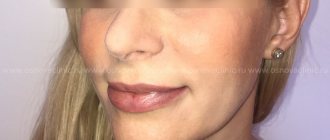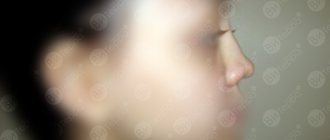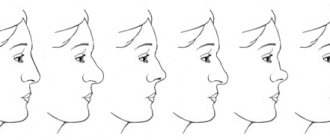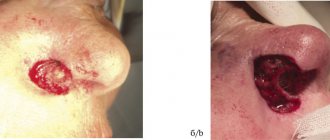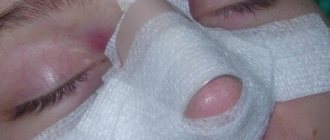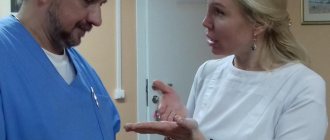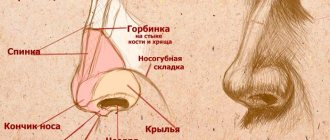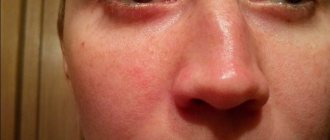02.11.2016
The nose is the most prominent and noticeable part of the face. It is he who first catches our eye when we look at other people or at our reflection. Leonardo da Vinci believed that an ideal face can be divided into 5 equal parts by vertical lines. According to this system, the width of the nose should be equal to the width of the eye. To determine how well your face matches ideal proportions, mentally draw down two vertical lines from the inner corners of your eyes. The wings and back of the nose should not protrude beyond these lines.
A nose that is too long or wide looks inharmonious, disrupts the proportions of the face and makes the eyes visually smaller. Rhinoplasty - plastic surgery to correct the shape of the nose - helps eliminate aesthetic defects and make facial features more correct and harmonious.
Operation
The nose consists of a bone-cartilaginous base and soft tissues.
At a preliminary consultation, the surgeon will listen to the patient’s wishes, conduct an examination, and determine which parts should be used to correct the shape of the nose. For example, a very wide nose can be reduced by removing small pieces of cartilage that form the tip of the nose. The reduced cartilage is tightened with sutures. The result is a newly formed, neat nose.
A wide, flat nose can be raised by bringing the cartilages set apart to the sides closer together. If necessary, you can also raise the bridge of your nose due to added tissue (artificial implants or your own cartilage tissue).
Flared nostrils can be reduced by cutting out pieces of skin at their base.
The operation is performed using an open or closed method.
When closed , the incision is made in the nasal cavity. The cartilages are isolated and their shape is corrected. The advantage of this method is the absence of external seams.
Open access is necessary for more extensive interventions. With it, incisions are made along natural skin folds (at the base of the nostrils). Also, an incision is often made along the columella - this is the lower part of the nasal septum, a strip of skin at the bottom of the nose between the nostrils. Open access provides much more opportunities for the surgeon’s work and visual control of the manipulations being performed. Moreover, after some time the seams become almost invisible.
The operation lasts on average 2 hours. The nose is plugged. A bandage is applied to it, and in case of bone grafting, a plaster cast is applied.
Nose job
Operation methods
Autogenic
- 1-1) Cartilaginous nasal septum Cartilage is taken from the nasal septum. This method is most often used for nasal tip surgery.
- 1-2) Ear cartilage Cartilage tissue is taken from the ear without leaving visible scars or changes in shape. This cartilage is usually curved and is used in the transformation of the tip of the nose.
- 1-3) Costal cartilage Taken from the rib, leaving a small scar (2-3cm). This cartilage is larger and stronger. This method is usually used in case
- 1-4) Subcutaneous fat (Dermo-fat) Taken from the thigh and does not leave visible scars. Subcutaneous fat has no side effects and can be used in nose bridge reshaping, nasal tip augmentation and revision surgery, but there is a risk of absorption.
Artificial
- 2-1) Silicone is commonly used in bridge conversion as it retains its shape and is easily removed.
- 2-2)Gortex Softer than silicone and does not create empty space around the implant, which causes complications.
Allogeneic tissues
- 3-1) Allogeneic cartilage Tissue transplantation from a donor is very safe, and eliminates the need to take your own cartilage and leave a scar.
- 3-2) AlloDerm (AlloDerm) Biological material that allows the body to mount its own tissue during the regeneration process. It has excellent healing properties. Used in nasal tip plastic surgery and internal transformations.
- 3-3)For Men The procedures used for men and women are the same, however the desired results are different. JK Clinic surgeons have extensive experience working with male clients from all over the world. We understand that everyone is looking for their own individual shape.
Types of operations.
Low nose.
Also known as augmentation rhinoplasty.
For people with low noses, a simple rhinoplasty can raise the bridge of the nose. This surgery is often done in conjunction with others to provide overall improvement. A simple rhinoplasty is done through a small incision inside the nose and the implant is inserted and set in place.
| Price | $2500-3500 |
| Duration | 30 min |
| Cut type | Inside the nose |
| Hospitalization | Not required |
| Recovery | 1 Week |
| Anesthesia | Sedation |
| Removing stitches | 7 days |
Flat nose.
A flat nose is characteristic of many Asians.
A low bridge and tip create the appearance of a flat face. Nose bridge augmentation and nose job can be combined to give a more sophisticated look and restore harmony to your face. Nasal bridge extension is performed using an implant or autogenous tissue. If necessary, nasal tip plastic surgery is performed using autogenous cartilage to widen and reshape the tip.
| Price | $2500-3000 |
| Duration | 30 min |
| Cut type | Inside the nose |
| Hospitalization | Not required |
| Recovery | 1 Week |
| Anesthesia | Sedation |
| Removing stitches | 7 days |
Aquiline nose.
A hooked nose (a nose with a hump) has protruding bone and cartilage at the bridge of the nose. This makes the face hard and masculine. Hooked nose surgery smooths out the hump and straightens the nose.
With minor violations of the nose line, the hump can be easily removed. However, in special cases, cartilage and bone must be removed and reconstructed to create the desired result. Often this procedure is done in combination with augmentation rhinoplasty and tip surgery (flat nose).
| Price | $4500-5500 |
| Duration | 2 hours |
| Cut type | Inside the nose |
| Hospitalization | Not required |
| Recovery | 1-2 weeks |
| Anesthesia | General anesthesia |
| Removing stitches | 7 days |
A long nose.
Typically, the nose appears long due to a long septum or drooping nasal tip. A long nose visually lengthens the face and disrupts overall harmony.
A long nose can be transformed by enhancing the ala cartilage, trimming the cartilaginous septum, or a combination of both. Our specialized surgeons will determine the most suitable surgical method depending on your individual circumstances.
| Price | $4500-5500 |
| Duration | 1.5 hours |
| Cut type | Inside the nose |
| Hospitalization | Not required |
| Recovery | 1-2 weeks |
| Anesthesia | Sedation |
| Removing stitches | 7 days |
Short nose.
An upturned tip of the nose visually shortens the nose. In most cases, it also opens the nostrils.
Correction of the nasal tip can be done using various methods based on the use of autogenous cartilage. If the bridge of the nose is low, these methods can be combined with rhinoplasty.
| Price | $4500-6000 |
| Duration | 2 hours |
| Cut type | Inside the nose |
| Hospitalization | Not required |
| Recovery | 1-2 weeks |
| Anesthesia | Sedation |
| Removing stitches | 7 days |
Crooked nose.
A crooked nose is irregularly shaped or curved. This can lead to nasal obstruction, which makes breathing difficult. Also, a crooked nose may have an unaesthetic appearance.
Reshaping of the nasal bone or cartilage is performed to correct a deviation or crooked nose. In most cases, the deviation is caused by a deviated nasal septum. Correcting the curvature is very important in order to prevent recurrence.
| Price | $5000-6000 |
| Duration | 2 hours |
| Cut type | Inside the nose |
| Hospitalization | Optional 1 day |
| Recovery | 1-2 weeks |
| Anesthesia | Sedation or general anesthesia |
| Removing stitches | 7 days |
Wide nose.
A wide nose can be caused by a wide bone structure of the nose, a wide tip of the nose, or wide nostrils. To solve this problem, osteotomy or narrowing of the base of the wings can be used. As a result, your nose becomes slimmer and more attractive.
There are various methods to reduce the width of the nose. The choice of method depends on the shape of the nose. Tapering the base of the wings can be used to reduce the size of the nostrils. Nasal tip surgery can make the tip slimmer. And changing the nasal bone will make your nose narrower and more beautiful.
| Price | $2000-6000 |
| Duration | 30 min - 2 hours |
| Cut type | Inside the nose |
| Hospitalization | Not required |
| Recovery | 1-2 weeks |
| Anesthesia | Sedation |
| Removing stitches | 7 days |
Repeated rhinoplasty.
Some clients are not satisfied with the results of the previous operation. In this case, revision surgery will help correct the shape and appearance of the nose. This procedure is recommended at least 6 months after the previous surgery.
The methods used in revision surgeries depend on various aspects. Uneven nose, narrowing of the nasal tip, implant displacement, infections, etc.
| Price | $3000-7000 |
| Duration | 2-3 hours |
| Cut type | Inside the nose |
| Hospitalization | Not required |
| Recovery | Sedation or General anesthesia |
| Anesthesia | Sedation |
| Removing stitches | 7 days |
"Back
Stationary stage
- The patient stays in the clinic’s hospital for 2-3 days under the constant supervision of medical personnel.
- We have single or double rooms.
- Each room has a shower, comfortable functional beds, to which oxygen is supplied.
- Each patient has an individual vital signs monitor.
- Tasty and high-quality food takes into account all medical recommendations.
- Each patient has an individual TV with headphones at his disposal.
Preparation for rhinoplasty
At the initial stage of preparation, a consultation with a plastic surgeon is required, who will conduct an examination, find out the reasons why the patient decided to undergo surgery, determine the type and volume of the intervention, and tell approximately how much nose plastic surgery costs. In order to achieve the best cosmetic results, photographs and computer modeling of the new nose are performed.
At the preparation stage, it is important to exclude contraindications. To assess the general condition of the patient, a comprehensive examination is prescribed, including the following diagnostic procedures:
- electrocardiogram;
- fluorography;
- general and biochemical blood test;
- general urine analysis;
- tests for hepatitis, HIV, STIs;
- coagulogram;
- CT scan of the skull.
Outpatient stage
Upon discharge from the hospital, the doctor sets a date for the patient’s next visit, gives recommendations, and talks about restrictions:
- For example, after surgery you should not eat very hot or cold foods, so as not to cause bleeding.
- Glasses need to be replaced with lenses, since in the first weeks the frame of the glasses can injure the nose.
- Of course, physical stress should be excluded for up to 2-3 months.
The doctor removes the tampons after 2-3 days.
Swelling in the nose and eyes disappears after about 10-20 days.
If a plaster cast is applied, it is removed after a week. 2 weeks after this, you can return to work (if the work does not involve physical activity).
General principles for selecting glasses
First of all, we note that it is incorrect to select frames based on the shape of the nose alone. We often tend to be too critical of our appearance and perceive a normal, neat nose as large, wide or long.
In order not to make the mistake of trying to disguise an invented flaw, it is necessary to perceive the face holistically. When choosing glasses you should pay attention to:
- Face shape
; - General dimensions of facial features;
- Softness or sharpness of contours.
Follow these rules:
- Rule of proportionality.
If you have a large nose, choose glasses that are the right size. Miniature frames will look alien on the face, while large models with large light openings (the height and width of the glasses lenses) will ensure harmonious integrity; - Soft/angular rule.
Choose frames that complement the nature of your lines and contours. If a clearly defined angularity dominates your face, we recommend playing up this highlight with the help of sharp-angled frames or bright geometry. For faces with smooth and soft lines, you should choose glasses with streamlined shapes. It is acceptable to use rounded models with angular details, for example, cat eye. These glasses will create a piquant edge on a soft face; - Rule of personal comfort.
It is very important that the glasses feel comfortable on your face - do not bounce, do not slide down and maintain the correct fit during sudden head movements. Glasses that are too narrow will put pressure on your temples and cause headaches; glasses that are too wide will slide off every time you turn or tilt your head. In this case, not only personal sensations will suffer, but also the effectiveness of vision correction; - End result rule.
Glasses are primarily a means of vision correction. Therefore, it is necessary to maintain a balance between the corrective function of glasses and their image role. Modern optics provide all the possibilities for this balance - the choice of frames is so diverse that choosing glasses that are good in every sense is no longer a problem. But before purchasing, you should consult with a specialist to make sure that the glasses you choose fit your prescription.
Is it possible to reduce the wings of the nose with threads?
The so-called non-surgical ligature lift of the wings of the nose is one of the low-traumatic methods of rhinoplasty. Lifting with threads can help correct some defects in the area of the wings of the nose, but it cannot completely replace rhinoplasty. The doctor inserts special threads under the skin using cannulas, and then can slightly change the length or shape of the nose, correct the asymmetry of the nostrils, and slightly reduce their width. The result is not very long-lasting, complications are possible, and the range of problems that can be solved is small.
Modern approaches to rhinoplasty
Plastic surgery does not remain aloof from modern trends in medicine, namely the transition to minimally invasive surgical interventions. Recently, in the field of maxillofacial surgery, a technique for working with bone tissue using piezo-ultrasound waves was introduced.
The use of classical osteotomy methods when performing rhinoplasty using chisels and hammers is becoming a thing of the past. The most important thing in osteotomy is strict adherence to the level of bone dissection to obtain an even cut and, as a result, prevention of the development of rough callus in the future. When using chisels, the risk of uncontrolled osteotomy is aggravated, the risk of splintered fracture of the nasal bones due to osteoporosis increases, and due to trauma to the soft tissues, swelling and hematomas persist for 3-4 weeks.
The use of a piezo instrument has become an indispensable assistant in the case of rhinoplasty with osteotomy. In addition to better osteotomy (preserving the structure of the nasal dorsum), the piezo instrument has another advantage - it preserves soft tissue structures, including blood vessels in the osteotomy area. This reduces the risk of hematoma formation in the postoperative period. After removing the plaster, most patients do not have bruises under their eyes, which is also an undeniable advantage of using a piezo instrument compared to a chisel. At the same time, the rehabilitation process goes much faster.
Thus, the undeniable advantages of the method are:
- Minimal soft tissue trauma.
- Very precise and predictable bone work.
- Additional asepsis and hemostasis during surgery.
Miracles of Makeup
With the right makeup on other parts of the face, you can divert attention from the nose.
- Blush. Apply brown-bronze blush from the center of the cheek, stretching it to the temples.
- Brows. Beautifully defined eyebrows in the form of a semicircle of medium thickness. Curl your eyebrows closer to your temple, then your eyes will be directed to their amazing line.
- Eyes. Emphasize the beauty of your eyes with this technique: apply eye shadow in a light, reflective shade to the inner corners of your eyes, and paint over the outer corners with a dark pencil. Thanks to this makeup, the nose will become smaller by visually increasing the distance between the eyes.
- Hairstyle. Create hair with volume at the back of your head. If you like bangs, then transparent, milled bangs will help to add lightness to a large nose.
A new safe way - contouring
Contouring is a synthesis of modern cosmetics and a new technique that was created specifically for correcting nasal defects.
Contouring was invented to give the desired look to the faces of Hollywood actors at the time of filming. Makeup artists used cosmetics that were close in color to the natural tone of the dermis. As a result, it seemed that the stars were completely without makeup.
Makeup artists have learned to change any part of the face: make cheekbones high, cheeks plump, nose perfectly shaped. It's a pity that this won't last forever. The previous shape of all parts of the face returns after makeup removal.
But the beauty of this technique is that every woman can learn to correct her flaws with only a set of correctors, brushes and other cosmetics.

